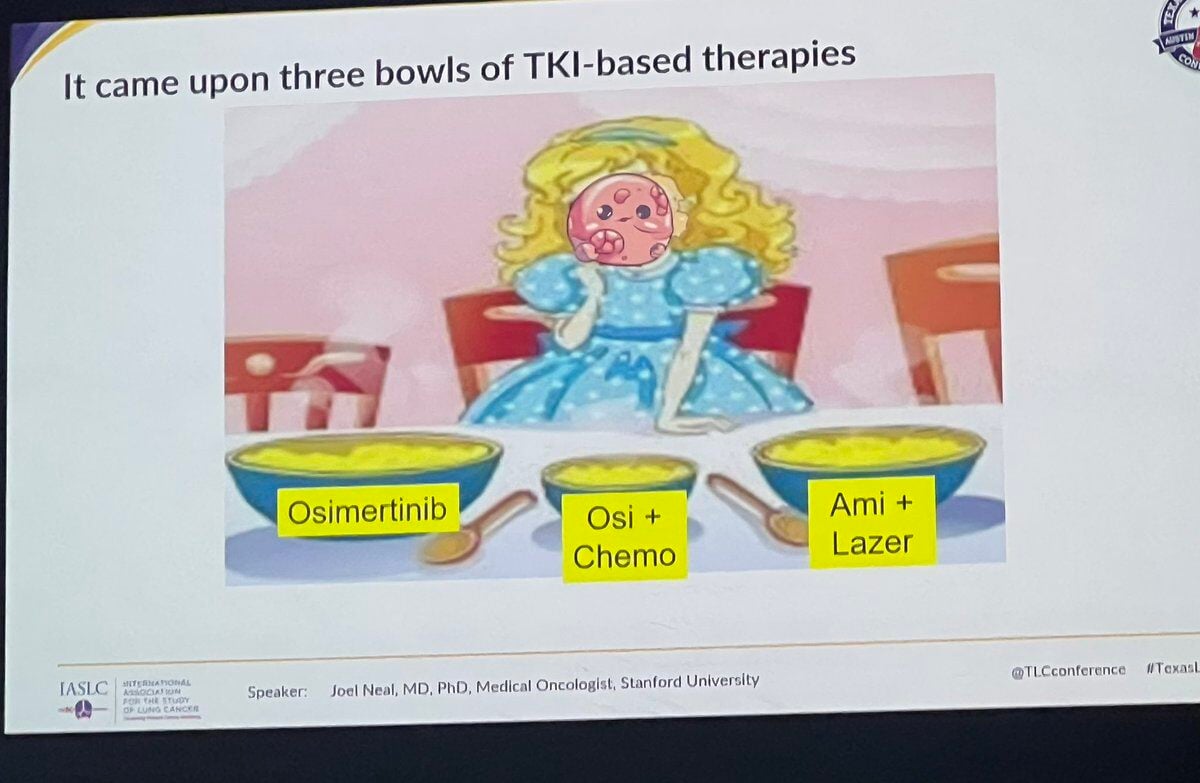4 min read
Lung Cancer KOLs Use Memes to Communicate EGFRmut Treatments
The Role of Memes in Communicating Lung Cancer Treatment Challenges: A Focus on EGFR Mutation Therapy In the realm of healthcare communication,...
2 min read
Brian Shields
:
Mar 31, 2025 7:36:12 PM

Nicolas Girard, MD, PhD, of Institut Curie in Paris, France reviewed with Lung Cancers Today on YouTube. compelling data from the MARIPOSA trial, which evaluated amivantamab plus lazertinib versus osimertinib for first-line treatment in EGFR-mutated non-small cell lung cancer. The primary endpoint of progression-free survival (PFS) by blinded independent committee review was successfully met. Amivantamab plus lazertinib significantly extended PFS from 17 months with osimertinib to 24 months, with a hazard ratio of 0.70, demonstrating substantial clinical benefit.
Dr. @EnriquetaFelip at #ASCO24 presenting data from MARIPOSA (1L amivantamab + lazertinib vs osimertinib) in pts with high risk #EGFR NSCLC. Previously reported: ami/lazer with superior PFS over lazertinib (mPFS 23.7m vs 16.6m, HR 0.70). Here - high risk subsets. pic.twitter.com/uDIIz3GcYD
— Stephen V Liu, MD (@StephenVLiu) May 31, 2024
The critical question facing clinicians is determining the optimal treatment sequence. Dr. Girard highlighted several potential approaches: starting with osimertinib followed by amivantamab plus chemotherapy (MARIPOSA-2 regimen), initiating treatment with amivantamab plus lazertinib, or considering other options such as chemotherapy plus osimertinib. Dr. Girard emphasized that overall survival is a crucial metric that reflects the entire treatment sequence.
Treatment sequence in EGFR mut+ is dependent on first line decision #ELCC25 @myESMO @OncoAlert @OncoReporte pic.twitter.com/xQPtGcAMua
— Bartomeu Massuti (@bmassutis) March 28, 2025
At ELCC 2025, the final overall survival analysis from MARIPOSA demonstrated significant benefits with amivantamab plus lazertinib versus osimertinib, with a hazard ratio of 0.75. The historical median overall survival with osimertinib was 37 months, while the median overall survival with amivantamab plus lazertinib has not yet been reached. Dr. Girard mentioned that the statistical analysis indicates the magnitude of difference in overall survival is expected to exceed 12 months, representing a clinically significant improvement.
Osimertinib BEATEN!! MARIPOSA (Ami + Lazer) shows significant OS (HR 0.75, p<0.005, 3yr 60% vs 51%) and landmark 3-yr icPFS improvement (36% vs 18%)—first combo to show OS superiority over SoC, extending OS beyond 3 years in 1L EGFRm NSCLC. #ESMOAmbassadors #ELCC25 @myESMO pic.twitter.com/cstBfz89iS
— Noemi Reguart (@NReguart) March 26, 2025
Dr. Girard emphasized that initiating treatment with amivantamab plus lazertinib not only prolongs first-line efficacy but also translates into an overall survival benefit. This suggests that amivantamab in the first-line setting impacts the entire treatment sequence. Biological data regarding resistance mechanisms indicates that the combination modifies the natural biological progression of the disease. Dr. Girard emphasized that the MARIPOSA data clearly demonstrates improved outcomes for patients, challenging the notion that osimertinib would remain the standard of care indefinitely.
Important to note that crossover was not allowed on #MARIPOSA — important to consider how many patients received subsequent therapy
— Eric K. Singhi, MD (@lungoncdoc) March 26, 2025
▫️74% in the amivantamab plus lazertinib arm received 2L therapy #ELCC25 @OncoAlert pic.twitter.com/Au5QhtKkeb
As with any new treatment regimen, clinicians have had to develop strategies to manage side effects associated with amivantamab plus lazertinib. Dr. Girard noted that prophylactic measures have been implemented to address dermatologic side effects (COCOON protocol) and infusion-related reactions (SKIPPirr protocol). He drew a parallel to the development of anti-emetic regimens for chemotherapy, highlighting that standardized prophylactic measures are now being established for amivantamab to optimize patient care and tolerability.
Amivantamab's biggest challenge has been its toxicity—the degree of OS benefit won't translate in the real world without supportive measures. Kudos to the sponsor for investing in these (IMO) practice-changing supportive measures.
— Eric K. Singhi, MD (@lungoncdoc) March 26, 2025
BOOKMARK this slide! @OncoAlert #ELCC25 pic.twitter.com/cmX3nNDQ0p

4 min read
The Role of Memes in Communicating Lung Cancer Treatment Challenges: A Focus on EGFR Mutation Therapy In the realm of healthcare communication,...